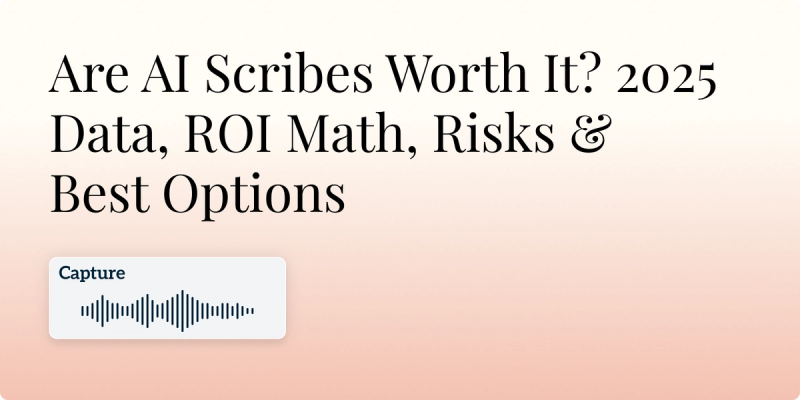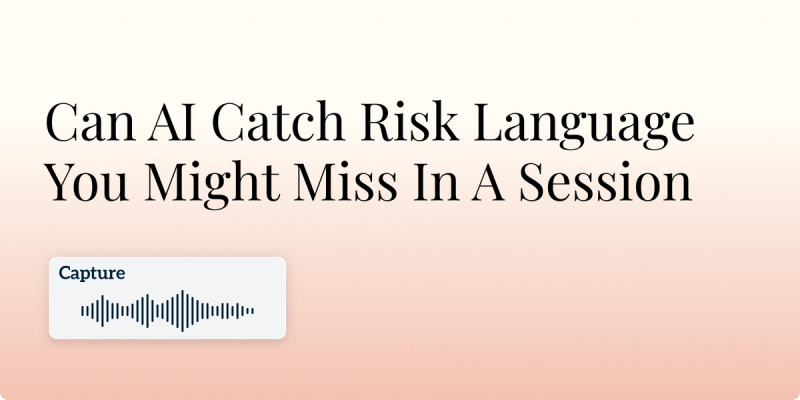
How to Stay HIPAA Compliant When Using AI in Mental Health

The integration of Artificial Intelligence into mental health is revolutionizing the field, offering unprecedented tools for efficiency and insight. From automating the creation of AI therapy notes to identifying patterns in treatment progress, the potential is vast.
However, this powerful innovation walks hand in hand with a significant responsibility: the unwavering protection of sensitive patient information. For any mental health professional, leveraging AI without a rigorous compliance framework is not just risky; it's a direct violation of federal law under HIPAA.
This guide will provide you with the essential actionable strategies to harness the power of AI in therapy while ensuring you fully safeguard patient data and maintain HIPAA compliance.
Understanding HIPAA in the Age of AI
Before integrating any AI tool into your workflow, a firm grasp of the relevant HIPAA rule is non‑negotiable. While the Privacy Rule governs the use and disclosure of Protected Health Information (PHI), the Security Rule is your primary focus when dealing with digital tools, as it sets the national standard for protecting electronic Protected Health Information (ePHI).
The HIPAA Security Rule: Your Foundation for Compliance
The Security Rule is structured around three types of safeguards, which together form a comprehensive framework for protecting ePHI. Think of them as pillars supporting your compliance efforts.
- Administrative Safeguards: These are the policies and procedures that manage the selection, development, implementation, and maintenance of your security measures. This is your “paperwork” foundation, including risk analyses, staff training, and contingency plans.
- Physical Safeguards: These controls limit physical access to your information systems and the facilities where they are housed. This includes policies for workstation use, device security, and controlling access to your server room or office.
- Technical Safeguards: This is the technology itself, the hardware, the software, and processes. These are used to protect ePHI and control access to it. This includes access controls, encryption, and audit controls.
When you use an AI tool, you are not just responsible for your own adherence to these safeguards, but you must also ensure that your vendor upholds them. This shared responsibility is the core of compliant AI use.
Why AI Presents Unique HIPAA Challenges
AI tools, particularly cloud‑based large language models (LLMs), introduce specific risks that traditional software does not. Understanding these is the first step toward mitigating them.
- Data Transmission: The moment you input client data into an AI tool, you are transmitting ePHI across a network, often servers owned and operated by a third party. This transmission must be secured end-to-end to prevent interception.
- Data Storage/Persistence: You must know what happens to the data after processing. Does the AI vendor store your prompts and the generated outputs? If so, where, for how long, and who has access? This “data persistence” creates a long-term liability if not properly managed.
- The “Human Review” Loophole: A critical, often overlooked risk is that many consumer-grade AI platforms use human reviewers to analyze user interactions to improve their AI models. This means a real person, employed by the AI company, could potentially read the intimate details of a therapy session. This is a clear and severe HIPAA violation unless explicitly permitted by a Business Associate Agreement.
A Strategic Framework for HIPAA-Compliant AI Implementation
Navigating these challenges requires a proactive and strategic approach. The following four‑step framework will guide you in building a compliant AI‑assisted practice.
1. Examine Your AI Vendor: The Business Associate Agreement (BAA)
A Business Associate Agreement is a legally binding contract required by HIPAA between a covered entity (you, the therapist) and a business associate (the AI vendor) that performs activities involving the use or disclosure of ePHI.
- The Non-Negotiable Rule: Never, under any circumstances, use an AI tool for ePHI without a signed BAA. Using a standard consumer-grade ChatGPT, Gemini, or Claude account to draft HIPAA AI notes is a direct violation. You must use a dedicated, enterprise-grade service that offers and signs a BAA.
Key Questions to Ask Potential AI Vendors:
- “Do you offer a signed BAA as part of your service?”
- “Where is our data physically stored and processed?”
- “Do you use any subprocessors? And are they also bound by a BAA?”
- “What is your data retention and deletion policy? Can we request immediate data deletion?”
2. Implement Technical Safeguards
Your vendor's technology must meet high security standards. Here's what to look for:
- Encryption is Key:
- In Transit: All data sent to and from the AI must be protected using Transport Layer Security (TLS) 1.2 or higher. You see this as “HTTPS” in your browser bar. This creates a secure tunnel that prevents eavesdropping.
- At Rest: ePHI stored on the vendor's servers must be encrypted using strong, industry-standard algorithms, such as AES-256. This ensures the data is unreadable even if the physical hardware is compromised.
- Access Controls and Authentication:
- The platform must support unique login credentials for each user in your practice. Shared logins are a violation.
- Multi-factor Authentication should be mandatory. MFA requires a second form of verification (eg, a code from an authenticator app) beyond just a password, drastically reducing the risk of unauthorized access from a stolen password.
- Audit Controls: The system must maintain detailed logs that record who accessed the system, what data they viewed or processed, and the date and time of access. These audit trails are essential for detecting and investigating security incidents.
3. Apply the Principle of Minimum Necessary Use
HIPAA’s “Minimum Necessary” standard dictates that you should only use or disclose the minimum amount of PHI necessary to accomplish the intended purpose. Apply this proactively when using AI.
- Before sending data to an AI, ask yourself: “What is the absolute minimum information this tool needs to perform its task?”
4. Train Your Staff and Document Everything
Technology is only one part of the solution. Your staff and processes are equally critical. This is where Administrative Safeguards come to life:
- Create a Clear AI Use Policy: Document which AI tools are approved for use with ePHI and explicitly forbid the use of non-compliant tools for any work-related task.
- Conduct Comprehensive Training: Train all staff on how to use the approved AI tools securely. This includes recognizing phishing attempts, understanding the importance of multi-factor authentication, and knowing how to identify and report a potential data breach.
- Maintain Meticulous Documentation: Your Risk Analysis, BAA, AI use policy, and training records are your proof of due diligence. In the event of an audit or investigation, the documentation demonstrates your commitment to compliance.
Technical Checklist For Vetting AI Therapy Tools
Compliance Area | What to Look For (Green Flags) | Red Flags and Deal Breakers |
|---|---|---|
Legal (BAA) | Willingness to sign a Business Associate Agreement before onboarding | Refusal to sign a BAA or claiming one is “unnecessary” |
Data Encryption | AES-256 encryption for data at rest; TLS 1.3 for data in transit. Clear Documentation of key management. | No clear encryption policy, use of outdated standards, or lack of transparency |
Access and Authentication | Role-Based Access Control, mandatory Multi-Factor Authentication, and unique user logins. | Shared team accounts, no MFA enforcement or weak password policies. |
Data Governance | Data centers located in the U.S with a clear data retention schedule. Data is not used for model training. | Indefinite data storage, data processed in overseas jurisdictions, or vague terms about data usage for AI improvement. |
Subprocessors and Audits | Transparency about subprocessors who are also BAA-bound. Regular third-party security audits (e.g., SOC 2 Type II) | Unwillingness to disclose partners or lack of independent security verification. |
Human Review | Contractual guarantee that no human review of your data occurs. | Policy stating that inputs may be reviewed by humans for quality assurance or training purposes. |
Case in Point: Using AI for Therapy Securely
Let's examine how these compliance principles apply to a common clinical scenario: generating therapy progress notes with AI. The difference between compliant and non‑compliant approaches carries significant legal consequences.
The Compliant Workflow
This secure, end‑to‑end process demonstrates proper AI implementation:
- Secure Access: Therapist logs into a BAA-covered AI Therapy notes platform using unique credentials.
- Anonymized Input: Therapist dictates notes using patient ID only, omitting direct identifiers.
- Protected Processing: Data is transmitted to secure servers.
- Professional Review: Therapist edits and finalizes the AI-generated content within the secure platform.
- Automated Cleanup: Vendor automatically deletes processing data per BAA retention policies.
The Non-Compliant Violation
A therapist uses a consumer AI chatbot to draft notes, pasting verbatim patient quotes with full personal details. This creates an immediate HIPAA breach because:
- No BAA protection for the transmitted ePHI.
- Data becomes training material for public AI models.
- Human reviewers may access sensitive clinical content.
- Lacking enterprise-grade security controls and audit trails.
The critical distinction isn't the AI technology itself, but the compliance framework governing its use. Proper implementation requires the security safeguards, legal contracts, and clinical oversight that only dedicated healthcare AI solutions provide.
Conclusion
The integration of AI into mental health represents a transformative shift in how we deliver and document care. Tools that automate AI Therapy notes and provide clinical insights offer potential to enhance therapeutic efficiency and effectiveness. However, this power must be harnessed responsibly. HIPAA compliance is not a barrier to innovation, but the essential framework that allows it to flourish sustainably and ethically. By selecting vendors who sign BAAs, enforcing technical safeguards, applying the principle of minimum use, and thoroughly training your staff, you create a secure environment for AI in therapy to thrive.
Frequently Asked Questions
ABOUT THE AUTHOR
Dr. Eli Neimark
Licensed Medical Doctor
Reduce burnout,
improve patient care.
Join thousands of clinicians already using AI to become more efficient.

Are AI Scribes Worth It? 2025 Data, ROI Math, Risks & Best Options
Are AI scribes worth it in 2025? See peer‑reviewed results, real costs, HIPAA & risk checks, and a simple ROI calculator - plus who should (and shouldn’t) buy.

Do You Need A BAA For Your AI Notes Tool? (Probably Yes)
Using AI for patient notes? Learn why a Business Associate Agreement is essential for HIPAA.

Can AI Catch Risk Language You Might Miss In A Session?
Learn how AI’s NLP can flag subtle risk language in session transcripts, acting as a safety net for patients.

